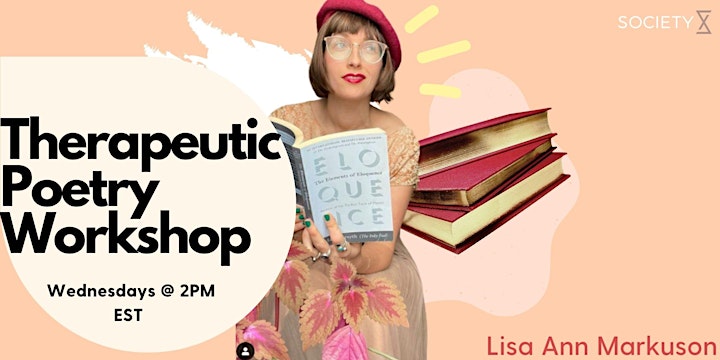
SocietyX – Poetry Therapy Workshop
More
December 22, 2021
About this event
Become your own muse. We’ll cover key poetic terms and devices by studying poems by a handful of modern and contemporary poets and then get a chance to try our own hand at writing new poem drafts from a select number of prompts. Throughout the course you will have the opportunity to workshop your poem drafts and get feedback on your work.
About La Marks
Founder of Ars Poetica, an international language arts agency specializing in interactive poetry.
Poetry Therapy
purple inkblots on collage of handwritten pagesPoetry therapy, a form of expressive arts therapy, involves the therapeutic use of poems, narratives, and other spoken or written media to promote well-being and healing. Therapists may use existing literature as part of treatment or encourage those in therapy to produce their own literary works to express deep-seated emotions. In either case, they offer a safe, non-judgmental atmosphere in which people in therapy are able to explore their written expressions and associated emotional responses.
Though any mental health professional might incorporate elements of poetry therapy into their therapeutic practice, the International Federation for Biblio/Poetry Therapy has developed a credentialing program for those individuals who wish to become certified or registered poetry therapists.
HISTORY AND DEVELOPMENT OF POETRY THERAPY
The healing effect of words has long been recognized. As far back as 4000 BCE, early Egyptians wrote words on papyrus, dissolve them in liquid, and gave them to those who were ill as a form of medicine. In more recent history, reading and expressive writing were employed as supplementary treatments for those experiencing mental or emotional distress. Pennsylvania Hospital, the first hospital established in the United States, reportedly employed this approach as early as the mid-1700s. In the early 1800s, Dr. Benjamin Rush introduced poetry as a form of therapy to those being treated. In 1928, poet and pharmacist Eli Griefer began offering poems to people filling prescriptions and eventually started “poemtherapy” groups at two different hospitals with the support of psychiatrists Dr. Jack L. Leedy and Dr. Sam Spector. After Griefer’s death, Leedy and others continued to incorporate poetry into the therapeutic group process, eventually coming together to form the Association for Poetry Therapy (APT) in 1969.
Librarians also played a major role in the development of this approach to therapy. Arleen Hynes, one pioneer in this area, was a hospital librarian who read about poetry therapy and began reading stories and poems aloud, facilitating discussions on the material and its relevance to each individual in order to better reach out to those being treated and encourage healing. She eventually began development of a training program for poetry therapy, around the time other individuals were doing the same. In 1980, all leaders in the field were invited to a meeting to formalize guidelines for training and certification. At that meeting, the National Association for Poetry Therapy (NAPT) formed out of what had been the APT.
As interest grew, several books and articles were written to guide practitioners in the practice of poetry therapy. Hynes and Mary Hynes-Berry co-authored the 1986 publication Bibliotherapy – The Interactive Process: A Handbook. More recently, Nicholas Mazza outlined a model for effective poetry therapy, also discussing its clinical application, in Poetry Therapy: Theory and Practice. The Journal of Poetry Therapy, established in 1987 by the NAPT, remains the most comprehensive source of information on current theory, practice, and research.This page contains at least one affiliate link for the Amazon Services LLC Associates Program, which means GoodTherapy.org receives financial compensation if you make a purchase using an Amazon link.
Today, poetry therapy is practiced internationally by hundreds of professionals, including psychologists, psychiatrists, counselors, social workers, educators and librarians. The approach has been used successfully in a number of settings—schools, libraries, hospitals, rehabilitation centers, and correctional institutions, to name a few—with various populations, including children, adolescents and the elderly.
HOW DOES POETRY THERAPY WORK?
As part of therapy, some people may wish to explore feelings and memories buried in the subconscious and identify how they may relate to current life circumstances. Poetry is believed to be beneficial to this process as it can often:
Be used as a vehicle for the expression of emotions that might otherwise be difficult to express
Promote self-reflection and exploration, increasing self-awareness and helping individuals make sense of their world
Help individuals redefine their situation by opening up new ways of perceiving reality
Validate emotional experiences and improve group cohesiveness by helping people realize many of their experiences are shared by others
Help therapists gain deeper insight into those they are treating
In general, poetry therapists are free to choose from any poems they believe offer therapeutic value, but most tend to follow general guidelines. It is recommended selected poems be concise, address universal emotions or experiences, offer some degree of hope, and contain plain language. Some poems commonly used in therapy are:
“The Road Not Taken” by Robert Frost
“The Journey” by Mary Oliver
“Talking to Grief” by Denise Levertov
“The Armful” by Robert Frost
“I Wandered Lonely as a Cloud” by William Wordsworth
Although the selection of material is usually done by the therapist, those being treated might be asked to bring to therapy a poem or other form of literature they identify with, as this may also provide valuable insight into their feelings and emotions.
TECHNIQUES USED IN POETRY THERAPY
A few different models of poetry therapy exist, but the most popular and most frequently used is the model introduced by Nicholas Mazza. According to this model, poetry therapy involves three major components: receptive/prescriptive, expressive/creative, and symbolic/ceremonial.
In the receptive/prescriptive component, the therapist will introduce a poem or piece of literature and encourage the person in therapy to react. Material is typically selected based on its ability to describe, explain and identify issues relevant to the content of the session. Selected material is usually read aloud by the therapist or the person in therapy so the tone and rhythm of the poem can be fully experienced. In the case of group, family, or couples therapy, individuals may take turns reading different stanzas or might be asked to read the entire poem in unison. While the poem is being read, the therapist notes the verbal and nonverbal reactions of the individual, and these reactions are generally explored after the reading with questions such as, “I noticed you were smiling as the poem was being read. Can you tell me about your reaction?” “Is there a particular line in the poem that touched you?” “How does this poem make you feel?”
The expressive/creative component involves the use of creative writing—poetry, letters, and journal entries–for the purpose of assessment and treatment. The process of writing can be both cathartic and empowering, often freeing blocked emotions or buried memories and giving voice to one’s concerns and strengths. Some people may doubt their ability to write creatively, but therapists can offer supporting by explaining they do not have to use rhyme or a particular structure. Therapists might also provide stem poems from which to work or introduce sense poems for those who struggle with imagery. A therapist might also share a poem with the individual and then ask them to select a line that touched them in some way and then use that line to start their own poem.
In group therapy, poems may be written individually or collaboratively. Group members are sometimes given a single word, topic, or sentence stem and asked to respond to it spontaneously. The contributions of group members are compiled to create a single poem which can then be used to stimulate group discussion. In couples therapy, the couple may be asked to write a dyadic poem by contributing alternating lines.
Letter writing, another effective therapeutic tool, may be a more accessible creative platform for some. One exercise involves writing a letter to the persona of a poem read in therapy. The letter may include expressions of approval or disapproval, and this process can clarify the individual’s initial reactions to the poem. A letter could also be addressed to any emotions presently causing difficulty in order to help a person visualize and externalize these feelings in the hope of gaining control over them. Individuals might also be encouraged to keep a personal journal during therapy and record their thoughts after hearing or reading a poem. Those in group therapy may have the opportunity to share their entries with group members.
The symbolic/ceremonial component involves the use of metaphors, storytelling, and rituals as tools for effecting change. Metaphors, which are essentially symbols, can help individuals to explain complex emotions and experiences in a concise yet profound manner. Rituals may be particularly effective to help those who have experienced a loss or ending, such as a divorce or death of a loved one, to address their feelings around that event. Writing and then burning a letter to someone who died suddenly, for example, may be a helpful step in the process of accepting and coping with grief.
HOW CAN POETRY THERAPY HELP?
Poetry therapy has been used as part of the treatment approach for a number of concerns, including borderline personality, suicidal ideation, identity issues, perfectionism, and grief. Research shows the method is frequently a beneficial part of the treatment process. Several studies also support poetry therapy as one approach to the treatment of depression, as it has been repeatedly shown to relieve depressive symptoms, improve self-esteem and self-understanding, and encourage the expression of feelings. Researchers have also demonstrated poetry therapy’s ability to reduce anxiety and distress in people diagnosed with a terminal illness.
Those experiencing posttraumatic stress have also reported improved mental and emotional well-being as a result of poetry therapy. Some individuals who have survived trauma or abuse may have difficulty processing the experience cognitively and, as a result, suppress associated memories and emotions. Through poetry therapy, many are able to integrate these feelings, reframe traumatic events, and develop a more positive outlook for the future.
People experiencing addiction may find poetry therapy can help them explore their feelings regarding the substance abuse, perceive drug use in a new light, and develop or strengthen coping skills. Poetry writing may also be a way for those with substance abuse issues to express their thoughts on treatment and behavior change.
Some studies have shown poetry therapy can be of benefit to people with schizophrenia despite the linguistic and emotional deficits associated with the condition. Poetry writing may be a helpful method of describe mental experiences and can allow therapists to better understand the thought processes of those they are treating. Poetry therapy has also helped some individuals with schizophrenia to improve social functioning skills and foster more organized thought processes.
It is important to note in most instances, especially in cases of moderate to severe mental health concerns, poetry therapy is used in combination with another type of therapy, not as the sole approach to treatment.

